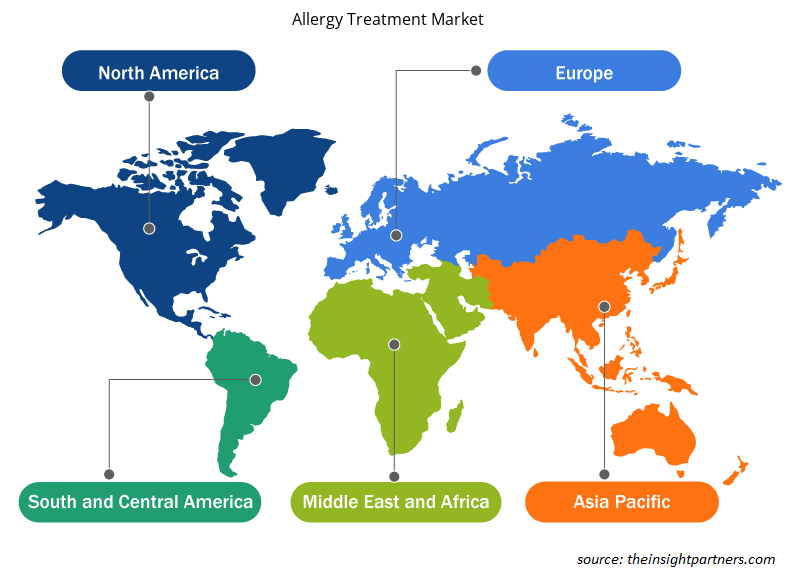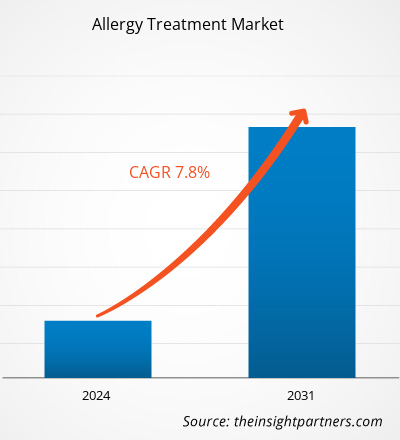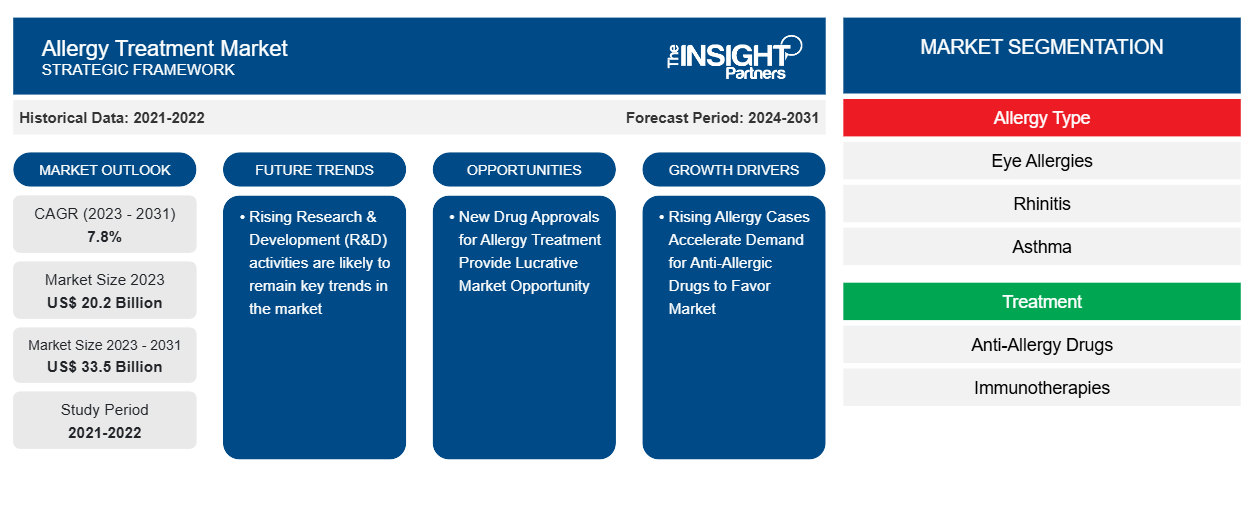من المتوقع أن يصل حجم سوق علاج الحساسية إلى 33.5 مليار دولار أمريكي بحلول عام 2031 من 20.2 مليار دولار أمريكي في عام 2023. ومن المتوقع أن يسجل السوق معدل نمو سنوي مركب بنسبة 7.8٪ خلال الفترة 2023-2031. ومن المرجح أن تظل أنشطة البحث والتطوير المتزايدة تمثل اتجاهات رئيسية في السوق.
تحليل سوق علاج الحساسية
من المرجح أن تظل أنشطة البحث والتطوير المتزايدة لعلاج الحساسية لتطوير عقاقير مبتكرة اتجاهًا جديدًا للسوق في السنوات القادمة. على الرغم من وجود العديد من الأدوية المسببة للحساسية في السوق، لا يزال العديد من المرضى الذين يعانون من حساسية الجهاز التنفسي والربو غير خاضعين للسيطرة الكافية أو لا يتم علاجهم بشكل كافٍ بالعلاج العرضي. على سبيل المثال، هناك العديد من حساسية الجهاز التنفسي التي تشكل خطرًا للإصابة بالربو. لذلك، تقوم العديد من الشركات المصنعة الكبرى بتصميم برامج التجارب السريرية للحساسية. "العلاجات المناعية لمسببات الحساسية" من شركة HAL Allergy BV للحساسية التنفسية للتجربة السريرية هي مثال على ذلك. لذلك، فإن أنشطة البحث والتطوير المتزايدة ستؤدي إلى تطوير عقاقير جديدة مضادة للحساسية ستشكل نموًا كبيرًا في السوق خلال الفترة 2021-2031.
نظرة عامة على سوق علاج الحساسية
وفقًا لتقرير عيادة الربو والحساسية، تكشف البيانات الجديدة التي نشرتها المنظمة العالمية للحساسية (WAO) أن 14% من الناس يعانون من الربو، مع معاناة 20% من التهاب الأنف التحسسي (AR)، مما يؤدي إلى التهاب الغشاء المخاطي للأنف بوساطة IgE . حاليًا، يعاني حوالي 20-30% من الناس في الهند من مرض حساسية واحد أو أكثر، ومن المتوقع أن يرتفع معدل الانتشار في السنوات القادمة. لذلك، فإن ارتفاع حالات الحساسية من شأنه أن يسرع الطلب على الأدوية المضادة للحساسية في العقد القادم.
قم بتخصيص هذا التقرير ليناسب متطلباتك
ستحصل على تخصيص لأي تقرير - مجانًا - بما في ذلك أجزاء من هذا التقرير، أو تحليل على مستوى الدولة، وحزمة بيانات Excel، بالإضافة إلى الاستفادة من العروض والخصومات الرائعة للشركات الناشئة والجامعات
-
احصل على أهم اتجاهات السوق الرئيسية لهذا التقرير.ستتضمن هذه العينة المجانية تحليلاً للبيانات، بدءًا من اتجاهات السوق وحتى التقديرات والتوقعات.
محركات وفرص سوق علاج الحساسية
ارتفاع حالات الحساسية يؤدي إلى تسريع الطلب على الأدوية المضادة للحساسية لصالح السوق
وفقًا لتقرير الأكاديمية الأمريكية لطب الأطفال، فإن النوع الأكثر شيوعًا من الحساسية هو حمى القش (التهاب الأنف التحسسي)، والذي يمثل التكلفة العالية للعلاج. على سبيل المثال، تتجاوز التكاليف المباشرة وغير المباشرة 7 مليارات دولار أمريكي سنويًا لعلاج الحساسية. لذلك، يعتمد العلاج الجيد للحساسية على التاريخ الطبي ونتائج اختبارات الحساسية، مع وجود أعراض خفيفة أو شديدة. بالإضافة إلى ذلك، يعد العلاج المناعي خيار علاج فعال لبعض مرضى الحساسية. هناك نوعان شائعان من العلاج المناعي. يتضمن ذلك حقن الحساسية والعلاج المناعي تحت اللسان (SLIT). تتضمن حقن الحساسية إعطاء حقن مسببات الحساسية بجرعة متزايدة بمرور الوقت. أيضًا، يصبح الشخص أقل حساسية تدريجيًا لمسببات الحساسية هذه حيث يمكن أن تعمل هذه الحقن بشكل جيد لبعض الأشخاص الذين يعانون من حساسية حبوب اللقاح والحيوانات الأليفة والغبار والنحل والحشرات اللاسعة الأخرى، وكذلك الربو. لذلك، تعمل حالات الحساسية المتزايدة على تسريع الطلب على الأدوية المضادة للحساسية التي تعمل كمحركات رئيسية لحصة سوق علاج الحساسية العالمية.
توفر الموافقات على أدوية جديدة لعلاج الحساسية فرصة سوقية مربحة
ستوفر الموافقات على الأدوية الجديدة لعلاج الحساسية فرصة سوقية مربحة لسوق علاج الحساسية. في يونيو 2020، أعلنت شركة Cadila Pharmaceuticals Limited عن إطلاق "شراب بيلاستين (30 مل)" وأقراص بيلاستين بقوة 20 مجم. بالإضافة إلى ذلك، في مارس 2022، أعلنت شركة Perrigo Company plc عن حصولها على الموافقة النهائية من إدارة الغذاء والدواء الأمريكية لاستخدام "Nasonex® 24HR Allergy (mometasone furoate monohydrate 50mcg) بدون وصفة طبية". تمثل الموافقة أول تحول من وصفة طبية إلى دواء بدون وصفة طبية لشركة "Nasonex" لدخول سوق الأدوية بدون وصفة طبية.
تقرير تحليل تجزئة سوق علاج الحساسية
إن القطاعات الرئيسية التي ساهمت في استخلاص تحليل سوق علاج الحساسية هي النوع والسبب ونوع الاضطراب والفئة والمستخدم النهائي.
- بناءً على نوع الحساسية، يتم تقسيم سوق علاج الحساسية إلى حساسية العين والتهاب الأنف والربو وحساسية الجلد وحساسية الطعام وغيرها. احتلت شريحة التهاب الأنف حصة سوقية أكبر في عام 2023.
- من حيث العلاج، يتم تقسيم السوق إلى أدوية مضادة للحساسية وعلاجات مناعية. وقد استحوذ قطاع أدوية مضادة للحساسية على أكبر حصة من السوق في عام 2023.
تحليل حصة سوق علاج الحساسية حسب المنطقة الجغرافية
ينقسم النطاق الجغرافي لتقرير سوق علاج الحساسية بشكل أساسي إلى خمس مناطق: أمريكا الشمالية، ومنطقة آسيا والمحيط الهادئ، وأوروبا، والشرق الأوسط وأفريقيا، وأمريكا الجنوبية والوسطى.
سيطرت أمريكا الشمالية على السوق. في منطقة أمريكا الشمالية، تمثل الولايات المتحدة أكبر حصة في سوق علاج الحساسية. إن وجود أفضل الشركات المصنعة في المنطقة وأدويتها المضادة للحساسية المبتكرة ذات النشاط الدوائي الفعال هي العوامل التي تساهم في هيمنة السوق. ومن المتوقع أن تنمو منطقة آسيا والمحيط الهادئ بأعلى معدل نمو سنوي مركب في السنوات القادمة.
رؤى إقليمية حول سوق علاج الحساسية
لقد قام المحللون في Insight Partners بشرح الاتجاهات والعوامل الإقليمية المؤثرة على سوق علاج الحساسية طوال فترة التوقعات بشكل شامل. يناقش هذا القسم أيضًا قطاعات سوق علاج الحساسية والجغرافيا في جميع أنحاء أمريكا الشمالية وأوروبا ومنطقة آسيا والمحيط الهادئ والشرق الأوسط وأفريقيا وأمريكا الجنوبية والوسطى.

- احصل على البيانات الإقليمية المحددة لسوق علاج الحساسية
نطاق تقرير سوق علاج الحساسية
| سمة التقرير | تفاصيل |
|---|---|
| حجم السوق في عام 2023 | 20.2 مليار دولار أمريكي |
| حجم السوق بحلول عام 2031 | 33.5 مليار دولار أمريكي |
| معدل النمو السنوي المركب العالمي (2023 - 2031) | 7.8% |
| البيانات التاريخية | 2021-2022 |
| فترة التنبؤ | 2024-2031 |
| القطاعات المغطاة |
حسب نوع الحساسية
|
| المناطق والدول المغطاة |
أمريكا الشمالية
|
| قادة السوق وملفات تعريف الشركات الرئيسية |
|
كثافة اللاعبين في السوق: فهم تأثيرها على ديناميكيات الأعمال
يشهد سوق علاج الحساسية نموًا سريعًا، مدفوعًا بالطلب المتزايد من المستخدم النهائي بسبب عوامل مثل تفضيلات المستهلك المتطورة والتقدم التكنولوجي والوعي المتزايد بفوائد المنتج. ومع ارتفاع الطلب، تعمل الشركات على توسيع عروضها والابتكار لتلبية احتياجات المستهلكين والاستفادة من الاتجاهات الناشئة، مما يؤدي إلى زيادة نمو السوق.
تشير كثافة اللاعبين في السوق إلى توزيع الشركات أو المؤسسات العاملة في سوق أو صناعة معينة. وهي تشير إلى عدد المنافسين (اللاعبين في السوق) الموجودين في مساحة سوق معينة نسبة إلى حجمها أو قيمتها السوقية الإجمالية.
الشركات الرئيسية العاملة في سوق علاج الحساسية هي:
- شركة جونسون آند جونسون للخدمات المحدودة
- سانوفي
- شركة AbbVie، Inc. (Allergan plc)
- شركة فايزر
- ليتيفارما
- شركة أيه إل كيه-أبيلو إيه/إس
إخلاء المسؤولية : الشركات المذكورة أعلاه ليست مرتبة بأي ترتيب معين.

- احصل على نظرة عامة على أهم اللاعبين الرئيسيين في سوق علاج الحساسية
أخبار سوق علاج الحساسية والتطورات الأخيرة
يتم تقييم سوق علاج الحساسية من خلال جمع البيانات النوعية والكمية بعد البحث الأولي والثانوي، والتي تتضمن منشورات الشركات المهمة وبيانات الجمعيات وقواعد البيانات. فيما يلي بعض التطورات في سوق علاج الحساسية:
- في فبراير 2024، أعلنت شركة نوفارتس عن موافقة إدارة الغذاء والدواء الأمريكية على "Xolair (omalizumab)". يُستخدم المنتج الذي تم إطلاقه حديثًا للحد من ردود الفعل التحسسية، بما في ذلك الحساسية المفرطة التي تحدث عند التعرض العرضي لطعام واحد أو أكثر لدى المرضى البالغين والأطفال الذين تتراوح أعمارهم بين عام واحد وما فوق والذين يعانون من حساسية الطعام بوساطة IgE. (المصدر: موقع شركة نوفارتس على الإنترنت، فبراير 2024)
تغطية تقرير سوق علاج الحساسية والمنتجات النهائية
يوفر تقرير "حجم سوق علاج الحساسية والتوقعات (2021-2031)" تحليلاً مفصلاً للسوق يغطي المجالات التالية:
- حجم سوق علاج الحساسية وتوقعاته على المستويات العالمية والإقليمية والوطنية لجميع قطاعات السوق الرئيسية التي يغطيها النطاق
- اتجاهات سوق علاج الحساسية بالإضافة إلى ديناميكيات السوق مثل المحركات والقيود والفرص الرئيسية
- تحليل مفصل لقوى PEST/Porter الخمس وSWOT
- تحليل سوق علاج الحساسية الذي يغطي اتجاهات السوق الرئيسية والإطار العالمي والإقليمي واللاعبين الرئيسيين واللوائح والتطورات الأخيرة في السوق
- تحليل المشهد الصناعي والمنافسة الذي يغطي تركيز السوق، وتحليل خريطة الحرارة، واللاعبين البارزين، والتطورات الأخيرة لسوق علاج الحساسية
- ملفات تعريف الشركة التفصيلية
- التحليل التاريخي (سنتان)، سنة الأساس، التوقعات (7 سنوات) مع معدل النمو السنوي المركب
- تحليل PEST و SWOT
- حجم السوق والقيمة / الحجم - عالمي، إقليمي، بلد
- الصناعة والمنافسة
- مجموعة بيانات إكسل
التقارير الحديثة
شهادات العملاء
سبب الشراء
- اتخاذ قرارات مدروسة
- فهم ديناميكيات السوق
- تحليل المنافسة
- رؤى العملاء
- توقعات السوق
- تخفيف المخاطر
- التخطيط الاستراتيجي
- مبررات الاستثمار
- تحديد الأسواق الناشئة
- تحسين استراتيجيات التسويق
- تعزيز الكفاءة التشغيلية
- مواكبة التوجهات التنظيمية























 احصل على عينة مجانية ل - سوق علاج الحساسية
احصل على عينة مجانية ل - سوق علاج الحساسية